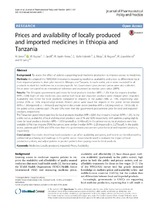| dc.contributor.author | Ewen, Margaret | |
| dc.contributor.author | Kaplan, W. | |
| dc.contributor.author | Gedif, T. | |
| dc.contributor.author | Justin-Temu, M. | |
| dc.contributor.author | Vialle-Valentin, C. | |
| dc.contributor.author | Mirza, Z. | |
| dc.contributor.author | Regeer, Barbara | |
| dc.contributor.author | Zweekhorst, M. | |
| dc.contributor.author | Laing, Richard | |
| dc.date.accessioned | 2017-03-13T07:22:09Z | |
| dc.date.available | 2017-03-13T07:22:09Z | |
| dc.date.issued | 2017 | |
| dc.identifier.citation | Ewen, M. et al. (2017). Prices and availability of locally produced and imported medicines in Ethiopia and Tanzania. Journal of Pharmaceutical Policy and Practice, 10(1): Art. #7 | en_US |
| dc.identifier.issn | 2052-3211 | |
| dc.identifier.uri | http://hdl.handle.net/10566/2622 | |
| dc.identifier.uri | http://dx.doi.org/10.1186/s40545-016-0095-1 | |
| dc.description.abstract | Background: To assess the effect of policies supporting local medicine production to improve access to medicines. Methods: We adapted the WHO/HAI instruments measuring medicines availability and prices to differentiate local from imported products, then pilot tested in Ethiopia and Tanzania. In each outlet, prices were recorded for all products in stock for medicines on a country-specific list. Government procurement prices were also collected. Prices were compared to an international reference and expressed as median price ratios (MPR). Results: The Ethiopian government paid more for local products (median MPR = 1.20) than for imports (median MPR = 0.84). Eight of nine medicines procured as both local and imported products were cheaper when imported. Availability was better for local products compared to imports, in the public (48% vs. 19%, respectively) and private (54% vs. 35%, respectively) sectors. Patient prices were lower for imports in the public sector (median MPR = 1.18[imported] vs. 1.44[local]) and higher in the private sector (median MPR = 5.42[imported] vs. 1.85[local]). In the public sector, patients paid 17% and 53% more than the government procurement price for local and imported products, respectively. The Tanzanian government paid less for local products (median MPR = 0.69) than imports (median MPR = 1.34). In the public sector, availability of local and imported products was 21% and 32% respectively, with patients paying slightly more for local products (median MPR = 1.35[imported] vs. 1.44[local]). In the private sector, local products were less available (21%) than imports (70%) but prices were similar (median MPR = 2.29[imported] vs. 2.27[local]). In the public sector, patients paid 135% and 65% more than the government procurement price for local and imported products, respectively. Conclusions: Our results show how local production can affect availability and prices, and how it can be influenced by preferential purchasing and mark-ups in the public sector. Governments need to evaluate the impact of local production policies, and adjust policies to protect patients from paying more for local products. | en_US |
| dc.language.iso | en | en_US |
| dc.publisher | BioMed Central Ltd. | en_US |
| dc.rights | © The Author(s). 2017 Open Access This article is distributed under the terms of the Creative Commons Attribution 4.0
International License (http://creativecommons.org/licenses/by/4.0/), which permits unrestricted use, distribution, and
reproduction in any medium, provided you give appropriate credit to the original author(s) and the source, provide a link to
the Creative Commons license, and indicate if changes were made | |
| dc.subject | Ethiopia | en_US |
| dc.subject | Government | en_US |
| dc.subject | Private sector | en_US |
| dc.subject | Public sector | en_US |
| dc.subject | Purchasing | en_US |
| dc.subject | Tanzania | en_US |
| dc.subject | Medicine | en_US |
| dc.title | Prices and availability of locally produced and imported medicines in Ethiopia and Tanzania | en_US |
| dc.type | Article | en_US |
| dc.privacy.showsubmitter | FALSE | |
| dc.status.ispeerreviewed | TRUE | |
| dc.description.accreditation | Scopus | en_US |

